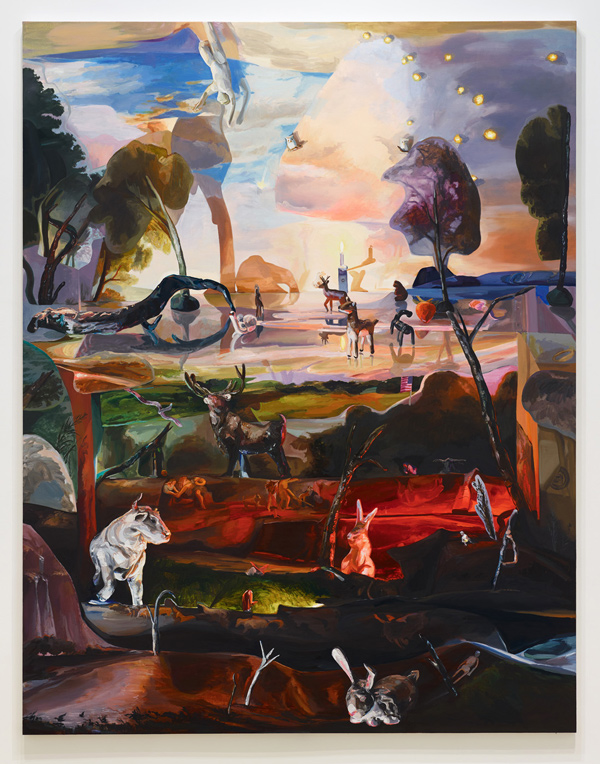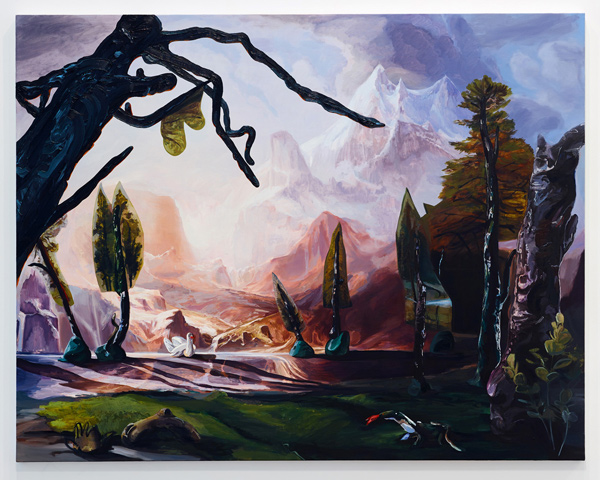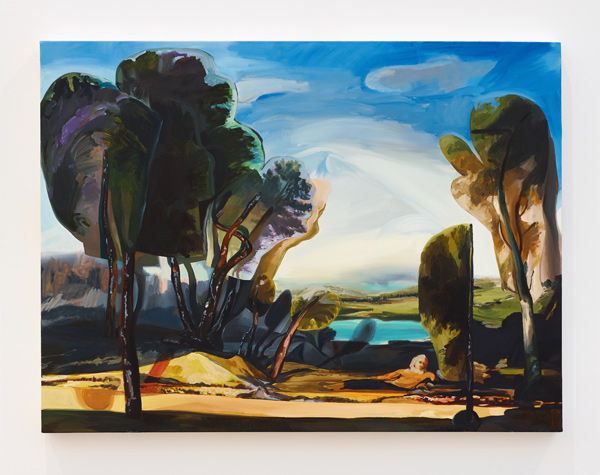The 19th-century landscape painter Albert Bierstadt may have been a deer whisperer, able to corral an entire herd to pose for “Among the Sierra Nevada, California,” but let’s be real. The deer are fake.
In Emma Webster’s recent foray into landscape painting, she takes up art’s exalted tradition of deceit. Webster doesn’t paint nature itself, though, but depictions of nature; not a scene, but its construction.

Emma Webster, Still Life (2018), Oil on canvas, 108 x 84 inches, Courtesy Diane Rosenstein Gallery.
The paintings are of dioramas, where clay figurines and cut-out trees populate famous landscape paintings (à la Bierstadt or Claude Lorrain, for example), and harsh makeshift lighting casts shadows on twilit sky, breaking the illusion of pictorial depth and the sublime.
Conceptually, “Arcadia” positions itself with works like Hiroshi Sugimoto’s photographs of Natural History Museum dioramas or Rodrigo Valenzuela’s time-dismantling photographs of photographs. Webster’s approach, though, has more humor than the gravitas of Sugimoto or Valenzuela, almost along the lines of Wayne White.

Emma Webster, The Hearing Forest and Seeing Field, 2018, Oil on canvas, 84 x 66 inches, Courtesy Diane Rosenstein Gallery.
Webster is most compelling when she takes full advantage of her medium. When it’s obvious that she’s painting a 2-dimensional cut-out of a tree planted in clay, the painting provides the same quick statement a photograph could. But when Webster obfuscates layers and blurs the distinction between elements, by a process only possible in paint, the force of the work comes not through statement, but through experience—the mind’s failure, and anxiety, over resolving what’s “real.”

Emma Webster, No Man’s Land (2018), Oil on canvas, 66 x 84 inches, Courtesy Diane Rosenstein Gallery.
Webster’s brushstrokes often have a certain uniformity in texture, dimension and contour –a clever strategy for solidifying disparate objects into a unified “space,” and for merging “space” with surface, but that uniformity has drawbacks, too. For example, some figures aren’t exactly realistically rendered, but are not unrefined or distorted enough to look intentionally so. This might not normally be an issue, but borrowing from famous “realistic” painters begs the question.

Emma Webster, Park Service (2018), Oil on canvas, 66 x 84 inches, Courtesy Diane Rosenstein Gallery.
Although “Arcadia” gazes heavily into the past, it definitely resonates with our present relationship with the artificial, which is ever increasing. Webster taps into this in her own vigorous, painterly way, and even though her humor seems to blunt the work’s own potential, “Arcadia’s” ersatz fantasies may still chart some new territory.
Emma Webster, “Arcadia,” February 9 – March 23, 2019, at Diane Rosenstein Gallery, 831 North Highland Avenue, Los Angeles, CA 90038. dianerosenstein.com



















0 Comments